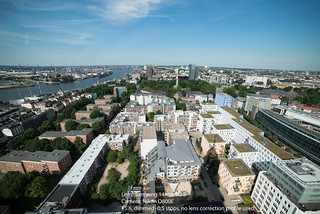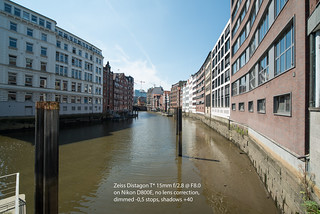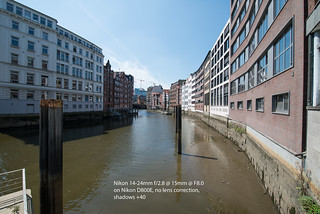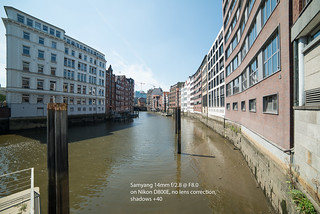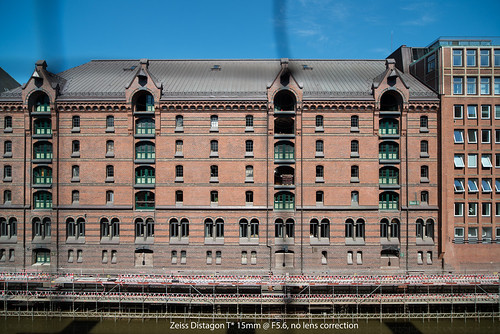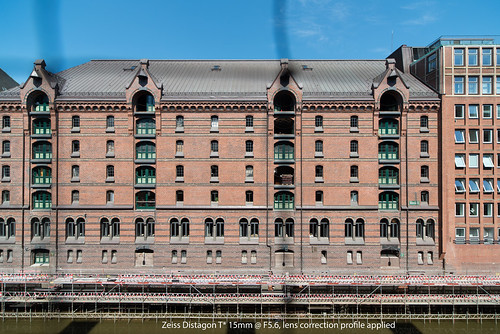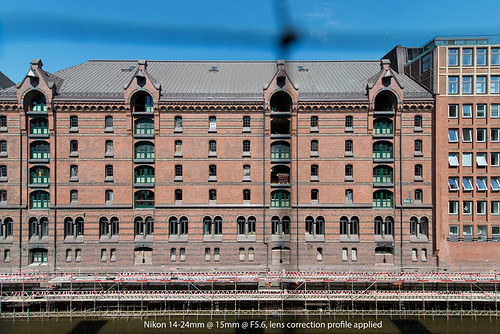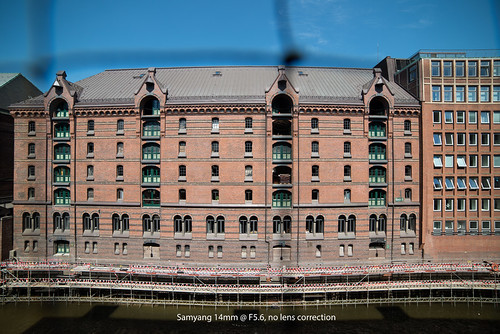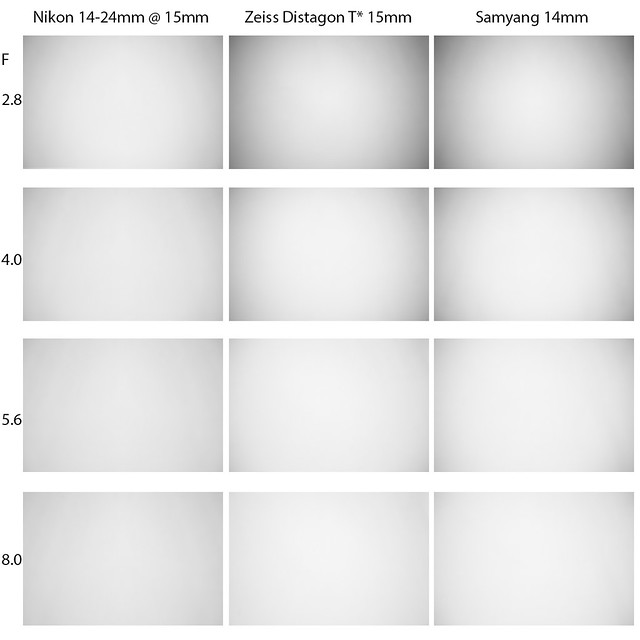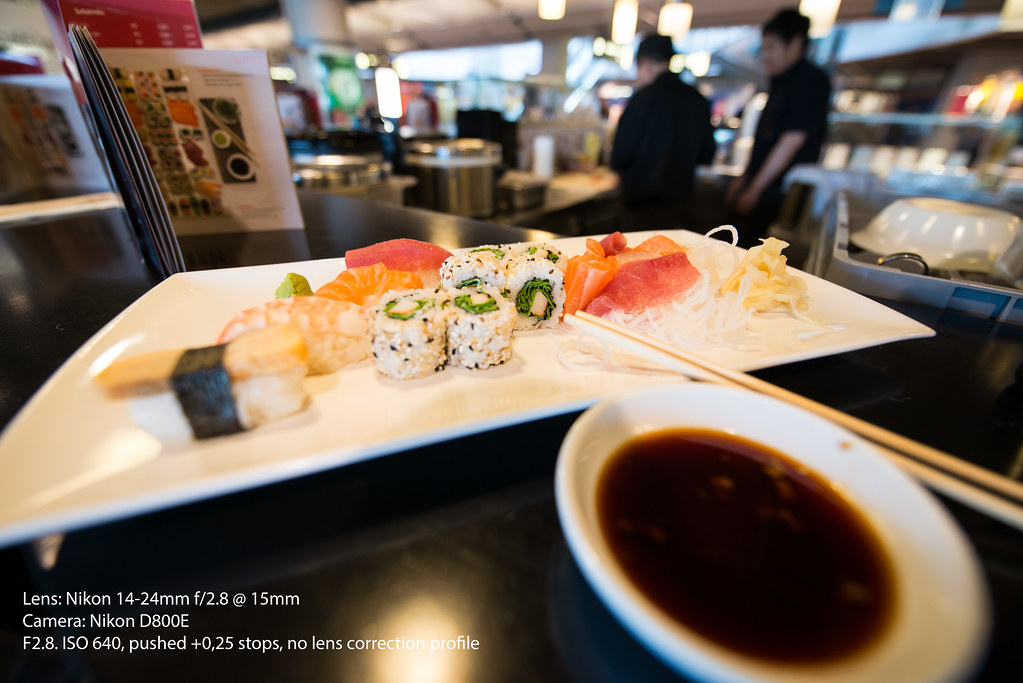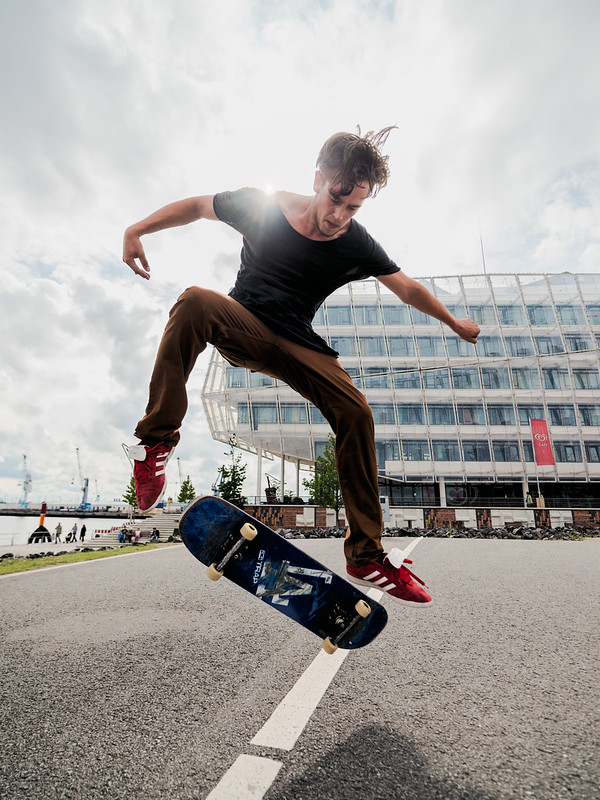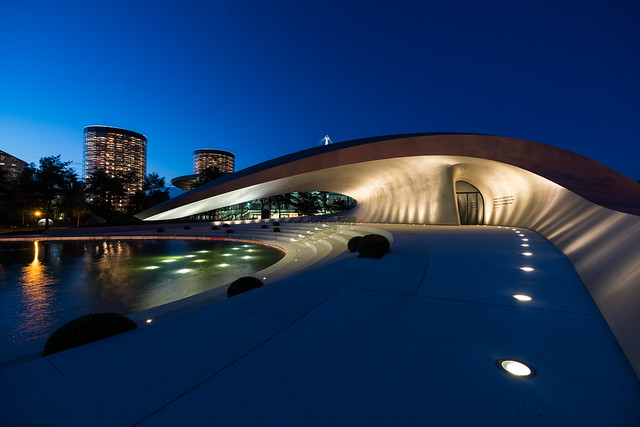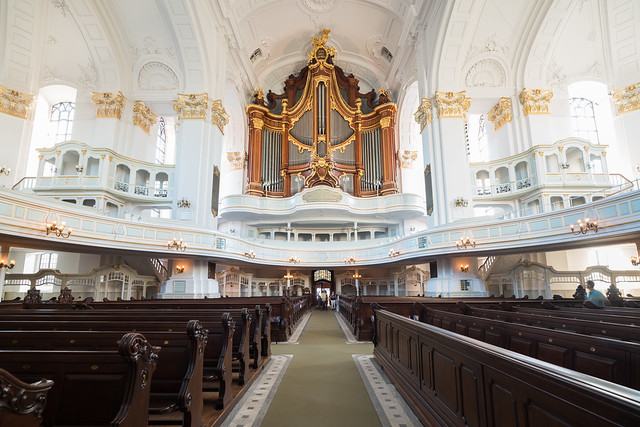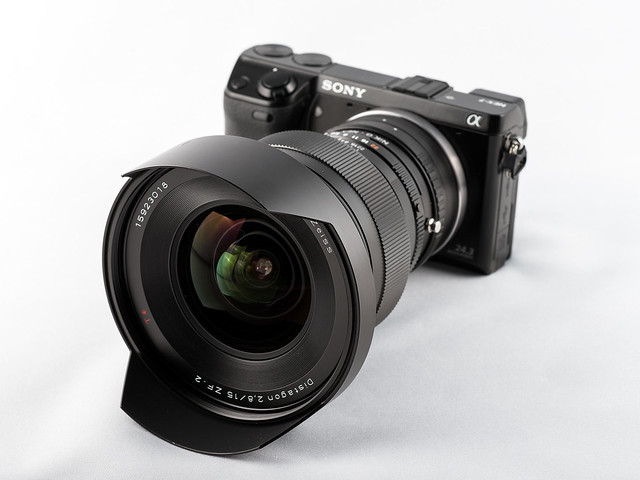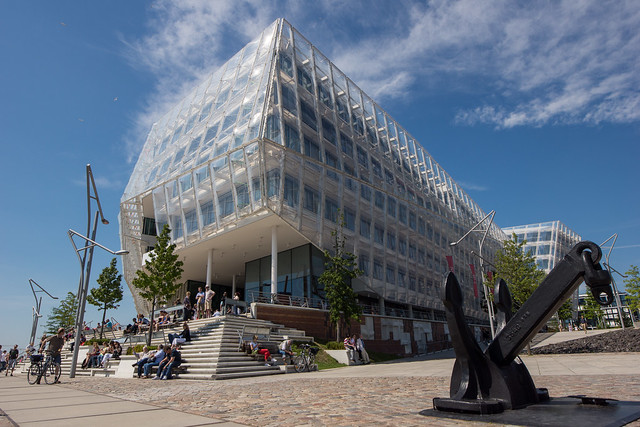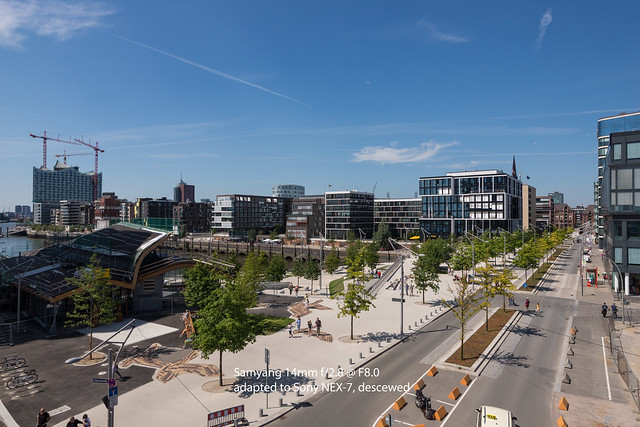Looking
for an ultrawide angle lens covering fullformat image circle? We compared the new Carl Zeiss Distagon T* 15 mm f/2.8
with the Samyang 14mm f/2.8 IF ED UMC Aspherical and the Nikon AF-S
NIKKOR 14-24 MM F/2.8G ED. With an angle of view of 110° (114° at 14mm),
a fast F2.8 aperture
and a minimum distance of about 25-28 cm they allow dramatic
perspectives for
close ups and are suitable for architecture and landscape photography as
well.
During this review we will compare
resolution/contrast, chromatic aberration, distortion, vignetting and
bokeh on typical real world examples as in my opinion this is more meaningful than just comparing
technical data and charts. The shots were taken with the "pixel monster" Nikon D800E
who's 36 MP sensor currently provides the highest resolution for full
frame cameras and with the Sony NEX-7 using an adapter from Novoflex. If
you ask yourself "why putting such a lens on the NEX-7 ?", her is my
motivation: With it's APS-C sized sensor it provides the same crop
factor than the D800 in DX mode or a Nikon D7000 but with 24 mega pixels
and so it challenges the lenses regarding resolution even more than the
D800E (that provides about 15 MP in DX mode). With it's currently unrivaled EVF
and 11.7x magnification it is much easier to precisely adjust the focus
to it's optimum compared to the D800E's liveview - especially at bright
outdoor light conditions. Last but not least, the NEX system still lacks
of sharp and fast super wideangle lenses and adapting ultra wide angles
designed for Leica M-mount at the NEX-7 usually produces colorshift on
the borders.
Size / weight / build / operation
A first review for the Zeiss Distagon T* 2.8/15 you can find already here so let's just sum up the most important technical data before we go into the image comparison. The different sizes are visible above and the weight you will have to carry (with Nikon F-mount) is about proportional to their sizes: ~550g for the 14mm Samyang, ~730g for the 15mm Zeiss and approx. 1000g for the 14-24mm Nikon. All three candidates are equipped with a chip delivering focal length and aperture information to the camera and allowing aperture control also through the camera. Filters (92mm thread) can only be screwed to the Zeiss. All are of good build quality, the Zeiss provides the best haptic and focus operation and comes with a metal lens hood. The Samyang has the longest focus throw - for my taste too long. You may find the Samyang also in identical construction under different names like Walimex Pro, Rokinon, Vivitar, Bower etc. My sample of the Samyang had a problem with the focus adjustment that is quite often reported by other users as well for that lens: Infinite focus is reached when the focus ring showed about 0.8m on the distance scale. In that aspect my point goes clearly to the Zeiss Distagon.
Resolution & contrast
Let us start at open aperture. All three lenses provide F2.8 which allows to shoot even at low light conditions and to play with depth of field and bokeh at least for objects in close up distances. For the comparison we start using a panoramic view:

(Zeiss Distagon 15mm @ F2.8, click on the image for other sizes; EXIF)
You may notice the vignetting at F2.8 but we will come back to that aspect later. This is a 100% crop with actual pixels from the center:
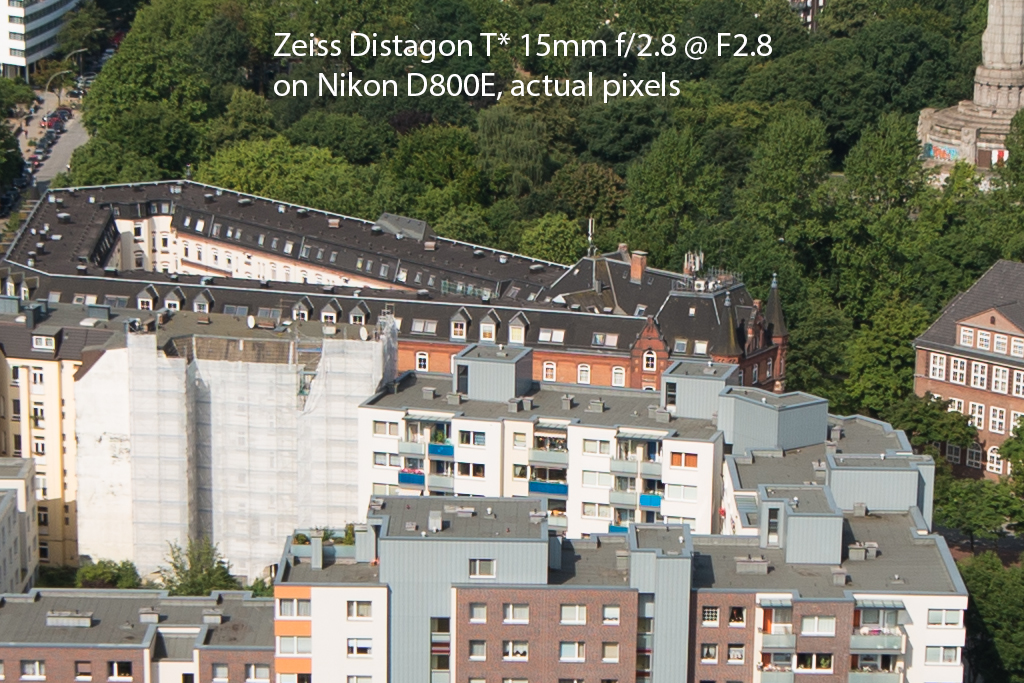
The same crop from the picture taken with the Nikon 14-24mm @ 15mm @ F2.8:
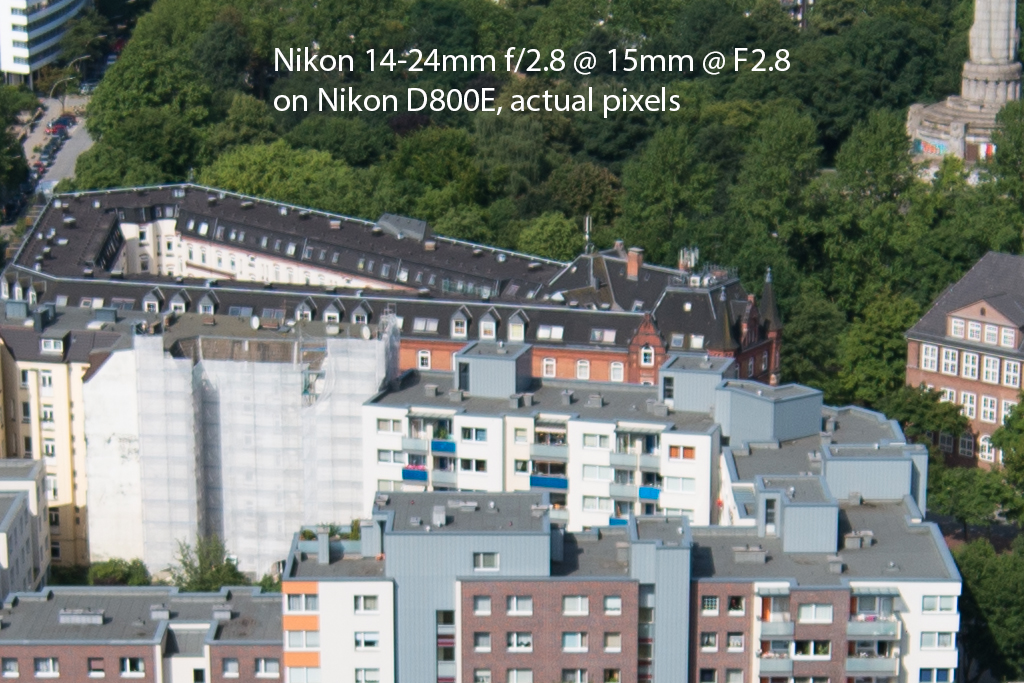
(click on the image to see the full image in other sizes)
The 100% crop from the picture taken with the Samyang 14mm @ F2.8:
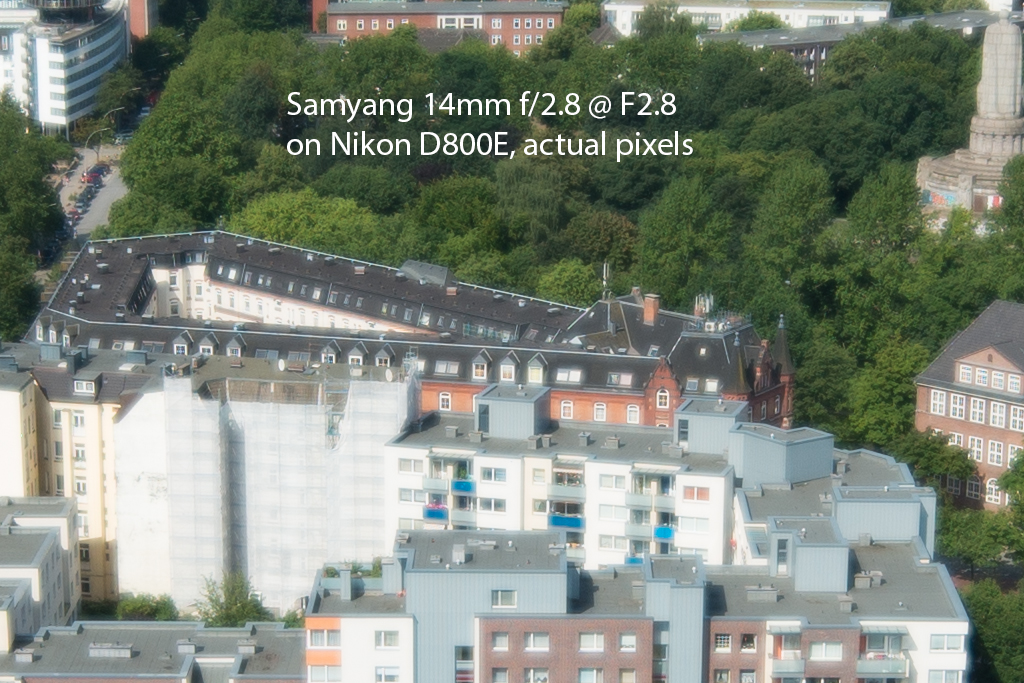
(click on the image to see the full image in other sizes)
Although
the resolution is quite OK, the Samyang has a significant
problem with high contrasts at F2.8. If you want to avoid that "glow"
you will have to stop down the Samyang at least to F3.5 or better F4.0.
You will see another open aperture comparison at low light / low
contrasts later in the "bokeh" comparison where the Samyang has less problems.
Now let us take a look at F5.6. Click on the previews (order: Zeiss / Nikon / Samyang) to open other sizes:
100% center crop (actual pixels) from the F5.6 sample with the 15mm Zeiss:

100% center crop (actual pixels) from the F5.6 sample with the Nikon 14-24mm @ 15mm:

100% center crop (actual pixels) from the F5.6 sample with the 14mm Samyang:
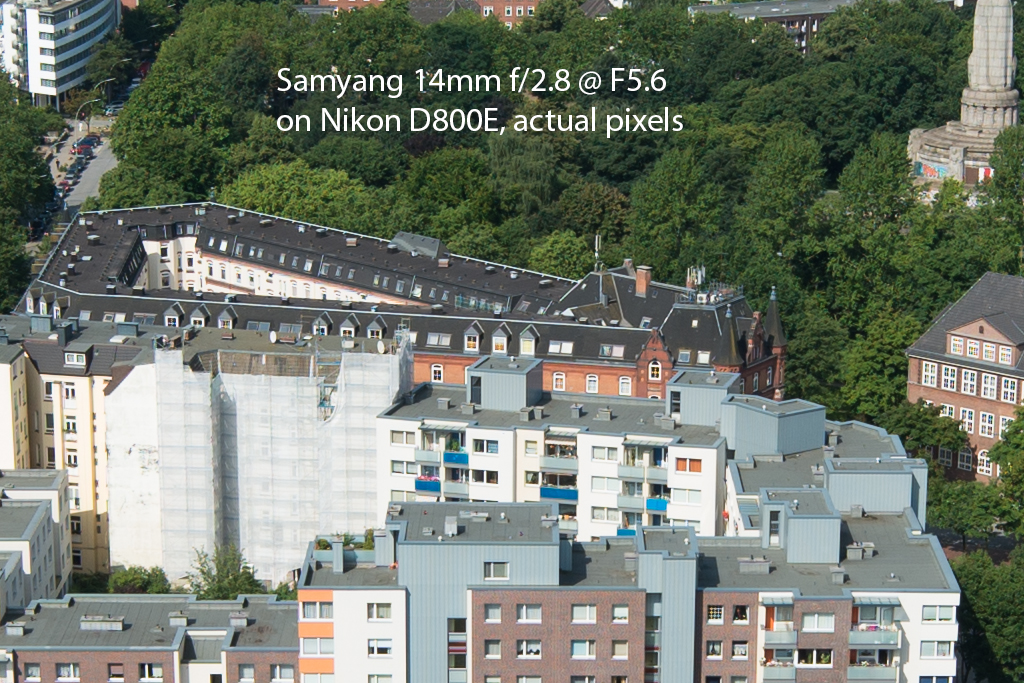
So
you see that at F5.6 all three candidates deliver very sharp centers,
the Nikon zoom shows slightly better contrasts here. As the images from
the Zeiss and the Samyang were about 0.5 to 0.8 F-stops overexposed and
had to be dimmed in that degree for better comparison, the difference in
contrast may also be caused a little bit by that. I recognized quite
often that the images with the Nikon zoom were about 0,2 to 0,8 stops
shorter exposed which may be caused by the different degree of
vignetting. We will take another look at center sharpness with the
higher sensor resolution provided by the Sony NEX-7 a little later but
before that we move to the borders of that panoramic view. Due to the
slightly wider viewing angle, in case of the Samyang the crops were
taken almost but not exactly from the boarders in order to catch the
same area for comparison:
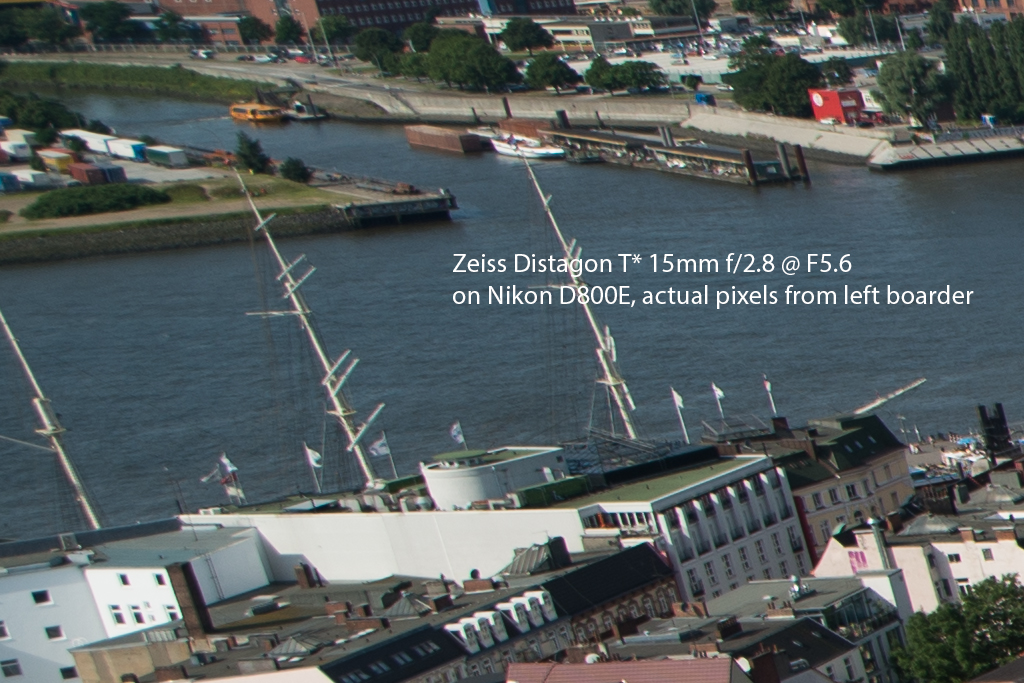

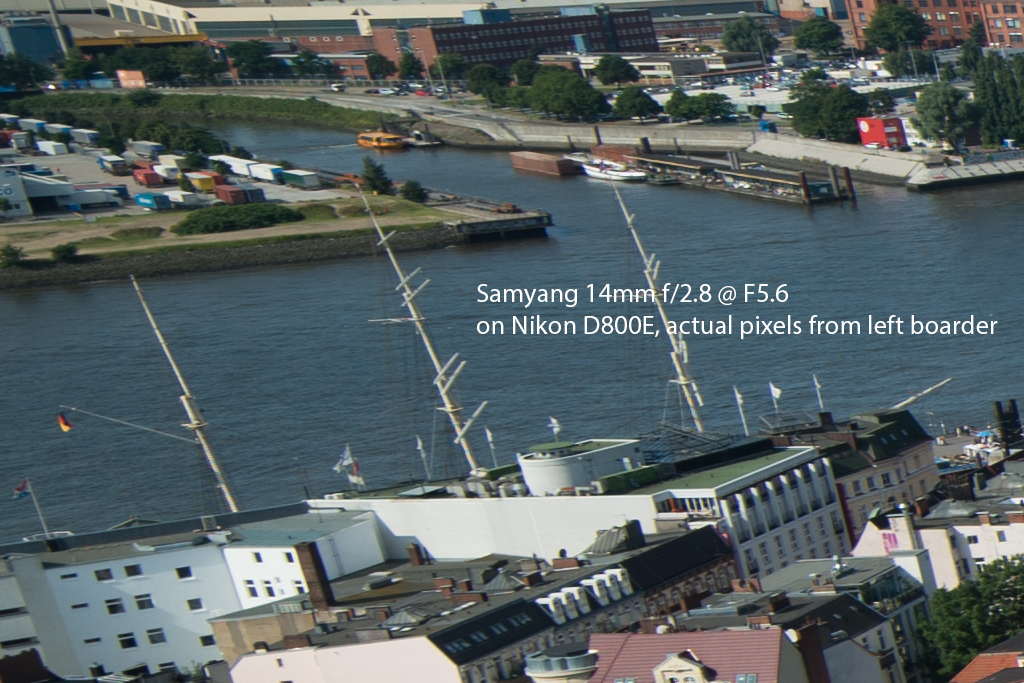

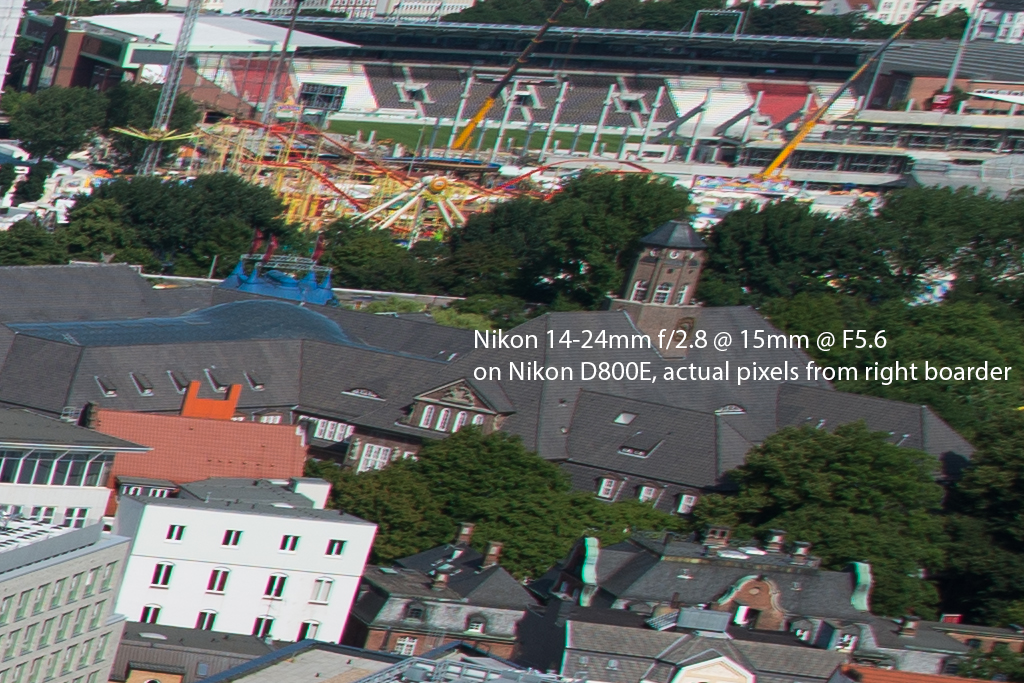
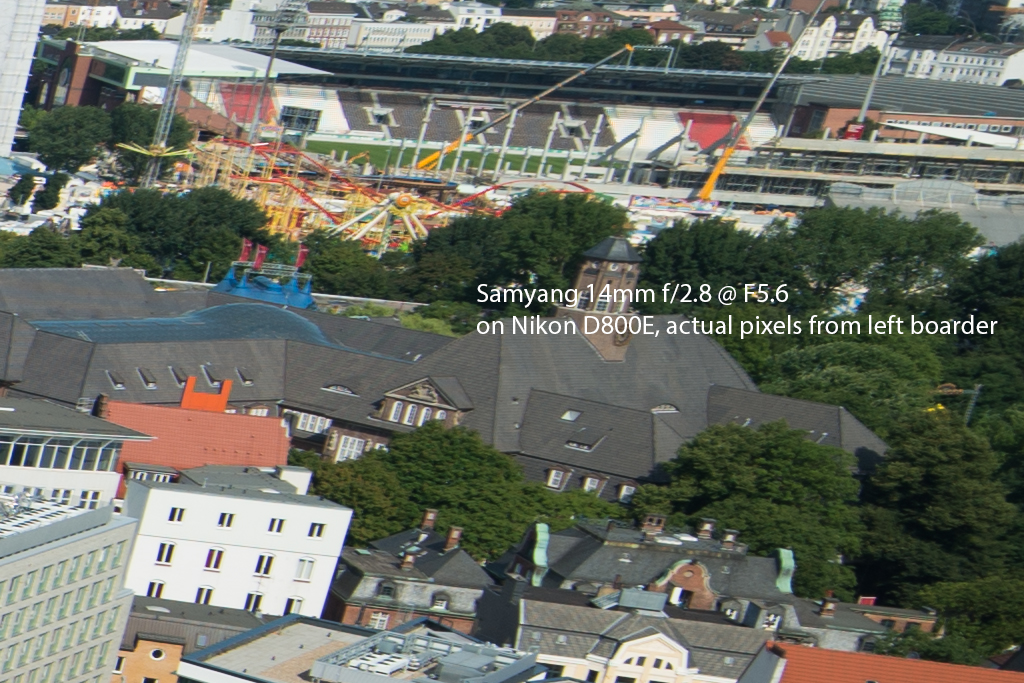
These examples show that the Nikon Zoom delivers the sharpest boarders but suffers from some chromatic aberrations (which can be quite easily corrected by software). The Samyang makes a surprisingly good job here.
For a short recreation break you may want to watch this animated 360° panorama taken from that location with the 15mm Zeiss:
(remember to select 1080p and switch to fullscreen view)
Quite often the top edges of landscape and architecture shots are filled with sky and the bottom is nearly as close as your feet at such a wide viewing angle, it is quite difficult to find a location that fills the edges as well with objects far away enough for a comparison. Let us take a look at this example taken from a bridge in order to allow also an edge comparison. Again first the previews (Zeiss / Nikon / Samyang) that you can click in order to open the full sizes:
To compare the center at an even higher resolution than the D800E can provide, we will take a look at the center crops from similar images taken with the Sony NEX-7 at F5.6:
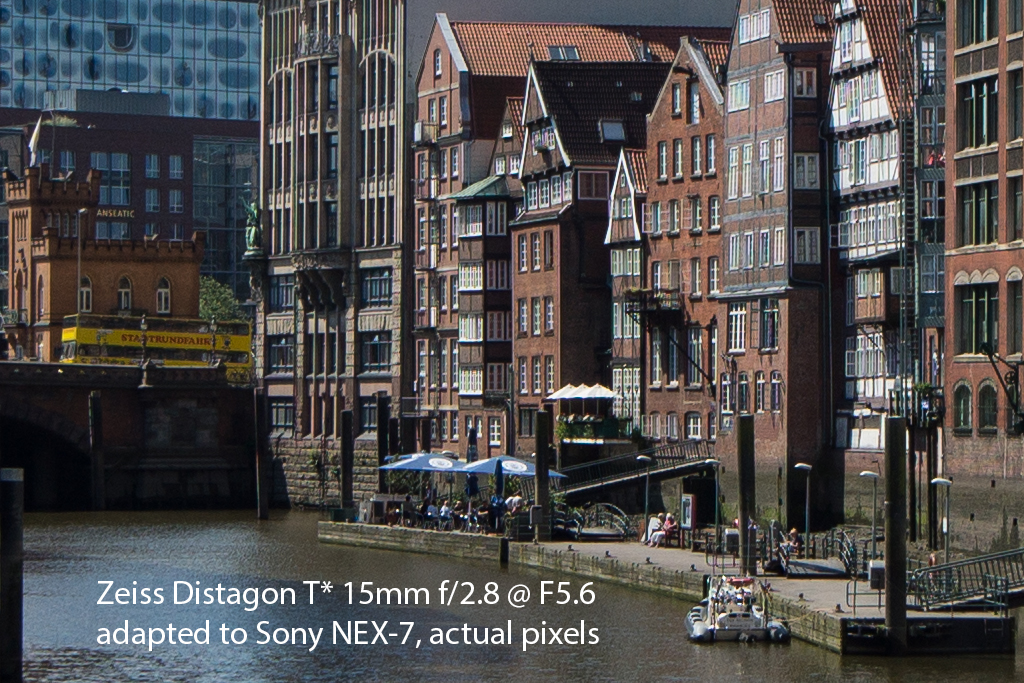


At this extremely high sensor resolution the Nikon zoom reaches it's limit and can not keep up completely with the prime lenses but on current full frame cameras you will propably not notice that difference. The Zeiss again shows a little better contrasts compared to the Samyang.
For the edge comparison we switch back to the images taken at full frame with the Nikon D800E at F8.0:



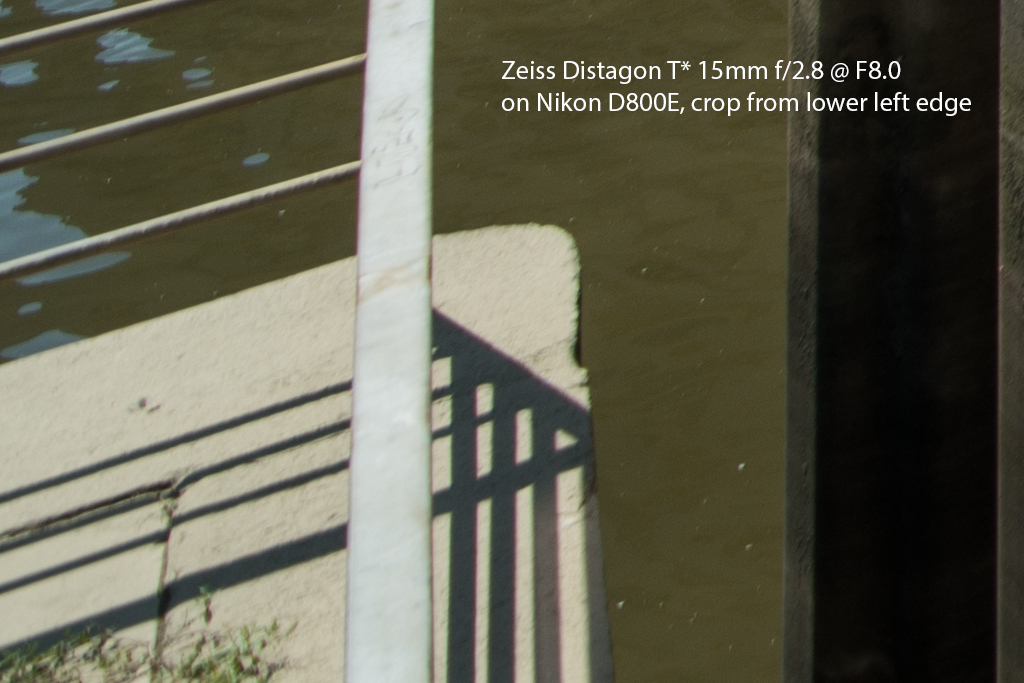
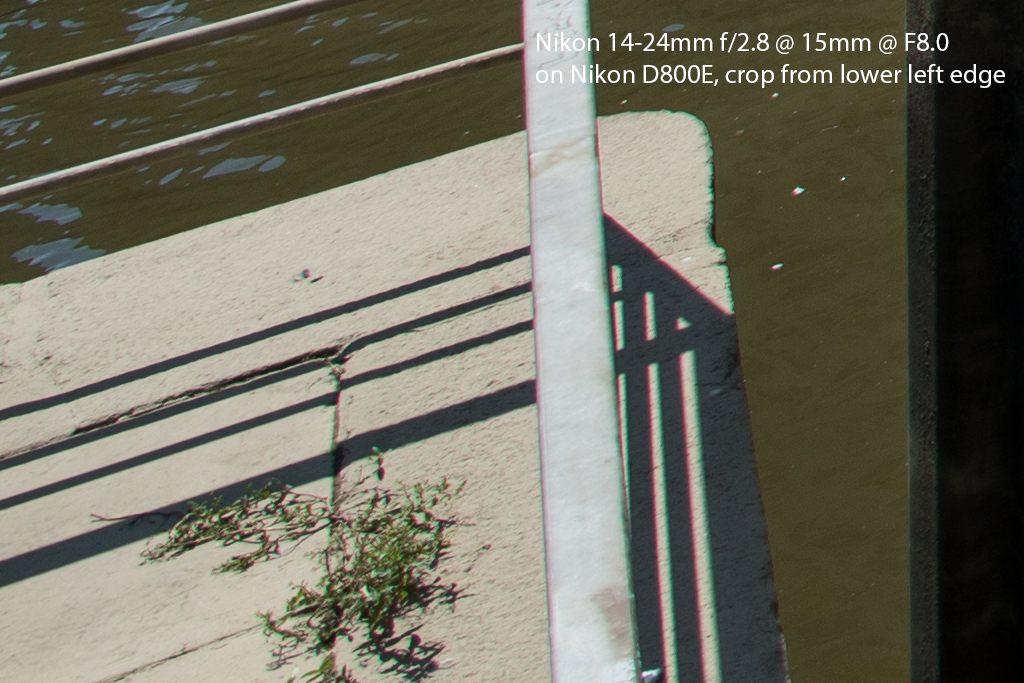
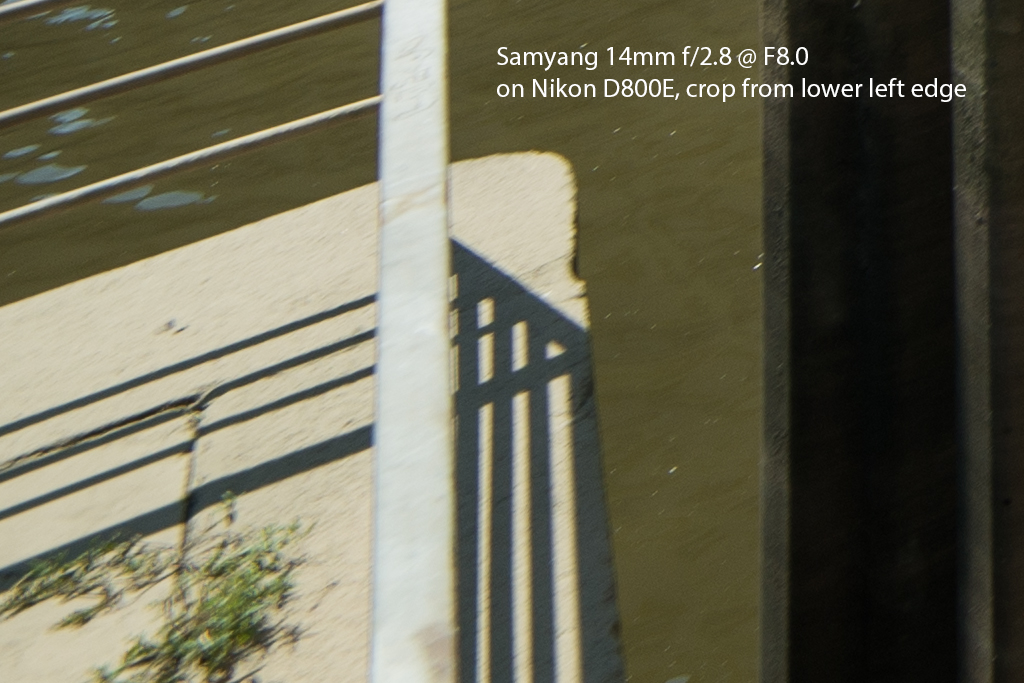
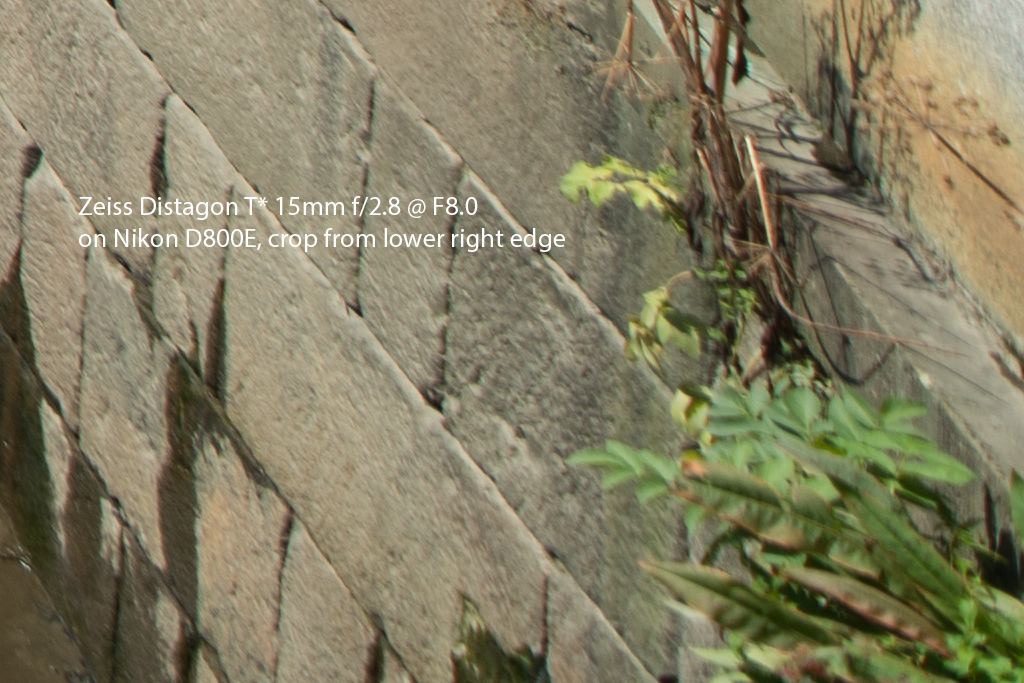

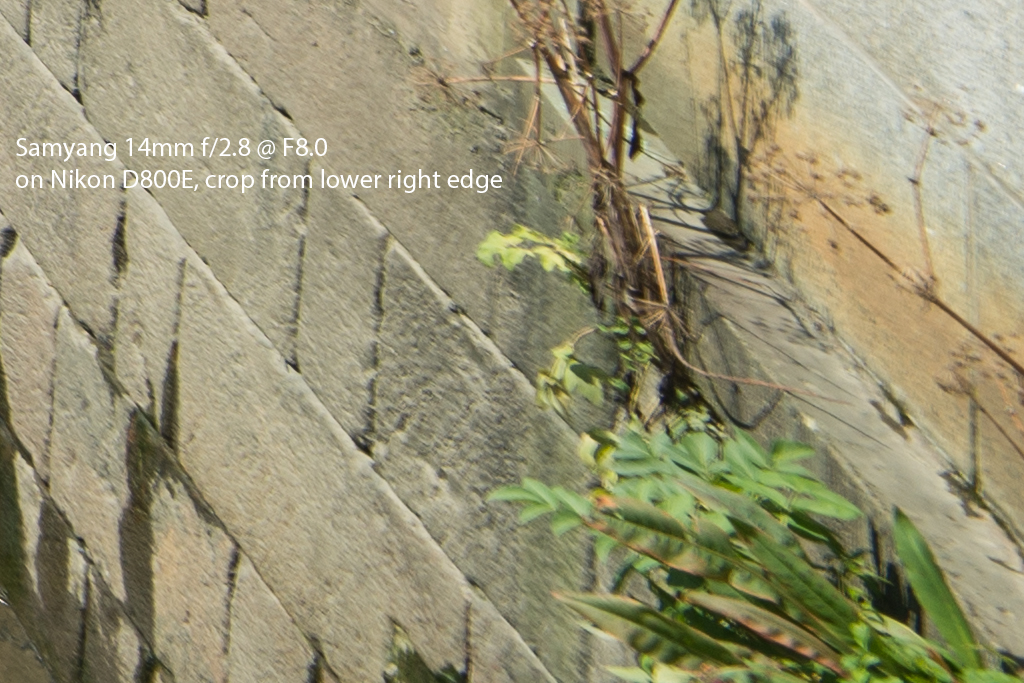

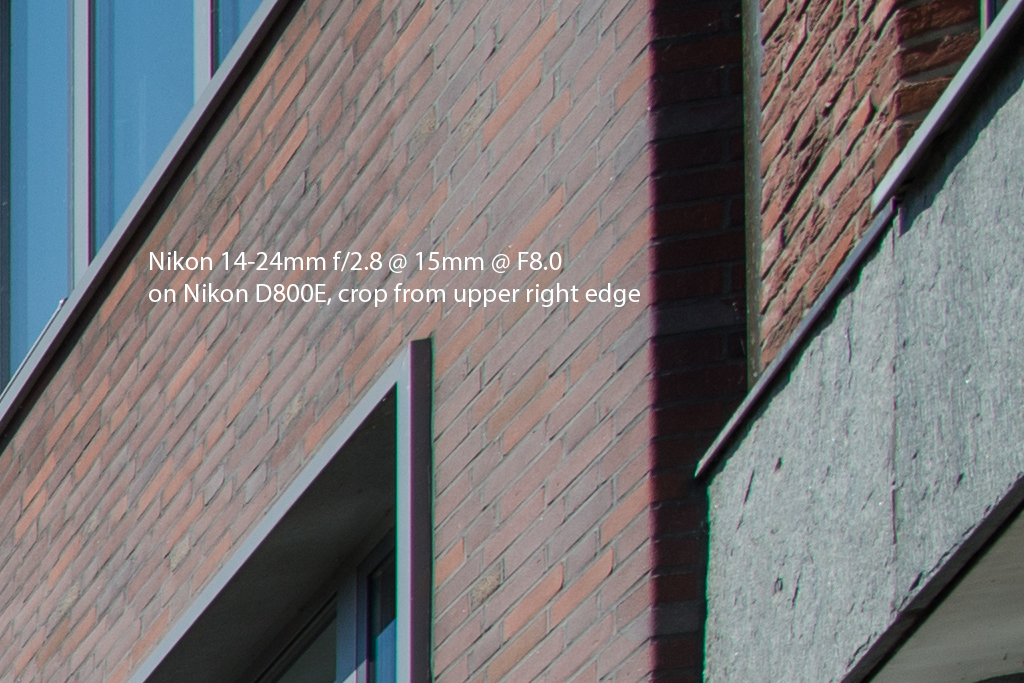
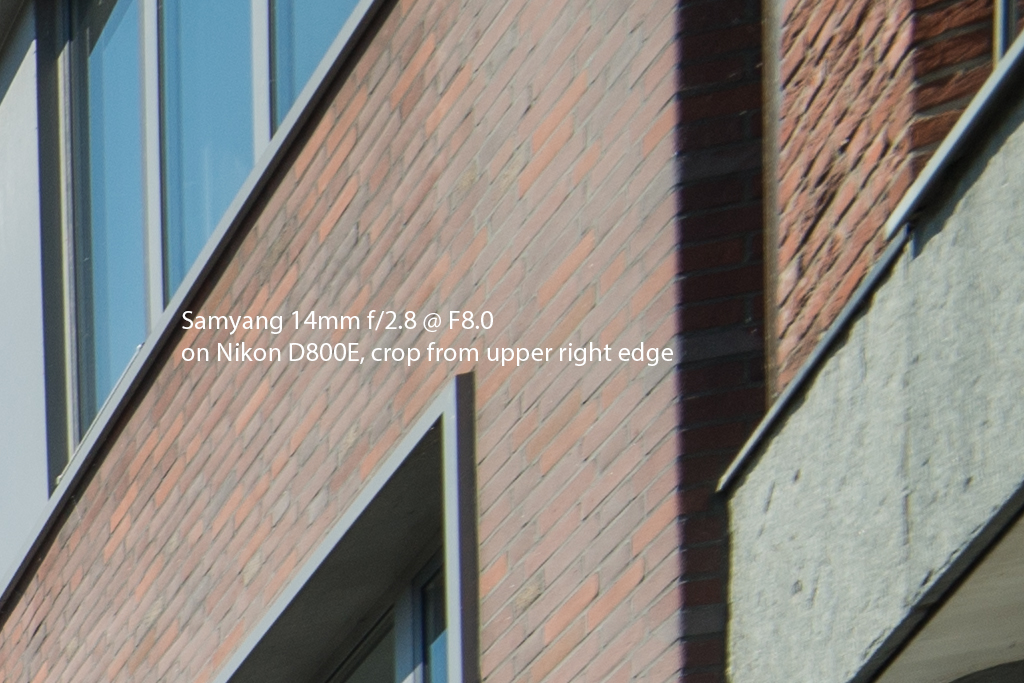
After already inspecting the left and right borders also in the edges the Nikon zoom shows the best performance. The little CAs can be corrected easily. I noticed some articles explaining edge blur with field curvature (e.g. in this article from Lloyd Chambers if you have an account for his site but this applies to a different type of lens). But when you shoot with extreme wide angles like these, you will notice that at F5.6 or F8.0 points at least from 3m to infinite will be sharp when focussing at infinite and you will find no different focus position that will make these edges sharper.
Overall there is no general winner in this aspect. The Zeiss performs extremely well already at F2.8 whereas the Samyang should be stopped down at least to F3.5 or 4.0 in good light / high contrast situations. The Nikon zoom performs very balanced at 15mm. It is good at F2.8 but not as perfect as the Zeiss. From F5.6 to F.8 all candidates show very good center performance but on the boarders and in the edges the Nikon zoom shows the best results. It may depend on your application area where which lens meets your requirements best. If you do a lot of work at F2.8, the Zeiss is you lens whereas the Nikon zoom is more universal.
Distortion
The following examples illustrate the degree of distortion and how the results can be optimized using a lens correction profile. Please ignore the blurry black shades as these images had to be shot through a net protecting the building from birds flying inside.
The 15mm Zeiss at F5.6 without and with correction (click on the images to see other resolutions):
The 14-24mm Nikon at 15mm and F5.6 without and with corection (click on the images to see other resolutions):
The 14mm Samyang at F5.6 without and with corection (click on the images to see other resolutions):
As you can see, the Zeiss produces the least distortions and needs only very little distortion correction. The lens correction profile for the Zeiss coming with current versions of Adobe Lightroom or Adobe Camera RAW plugin for Photoshop corrects also the vignette depending on the aperture used. The Nikon zoom needs a little bit more distortion correction but less vignette correction. Most significant is the distortion produced by the Samyang which some articles compare to a "mustache". PTLens does but Adobe's Lightroom and Camera Raw do not provide a lens correction profile for the Samyang but meanwhile you can download and choose from several profiles using the download function built in Photoshop or the lens profile downloader. In this aspect the point goes to the Zeiss as with all these subsequent transformations you will loose some time and a little degree of resolution (but the Nikon D800E delivers so many pixels that you can get over this ;-).
Fall off / Vignetting
As you may already have noticed from the earlier examples, there is a certain degree of vignetting that you may have to take into account especially at open aperture with the Zeiss and the Samyang. In some situations this may be desired as it draws more attention to the center in other situations you may be forced to apply some vignette correction which increases noise when the image was taken with high ISO settings. The following chart shows the amount of vignetting:
Regarding vignetting, the point goes to the Nikon zoom.
Playing with DOF / Bokeh
If you shoot such a lens at open aperture, you can create some nice looking close ups with creamy background:
All three candidates are able to produce a nice bokeh and under these low light / low contrast conditions the results from the Samyang are acceptable at open aperture as well although in magnification you still will see significantly more micro contrast in the image taken with the Zeiss.
The Zeiss demonstrates it's F2.8 capabilities already impressively in the title image. Here is a 100% crop (actual pixels) from that ISO 3200(!) image:
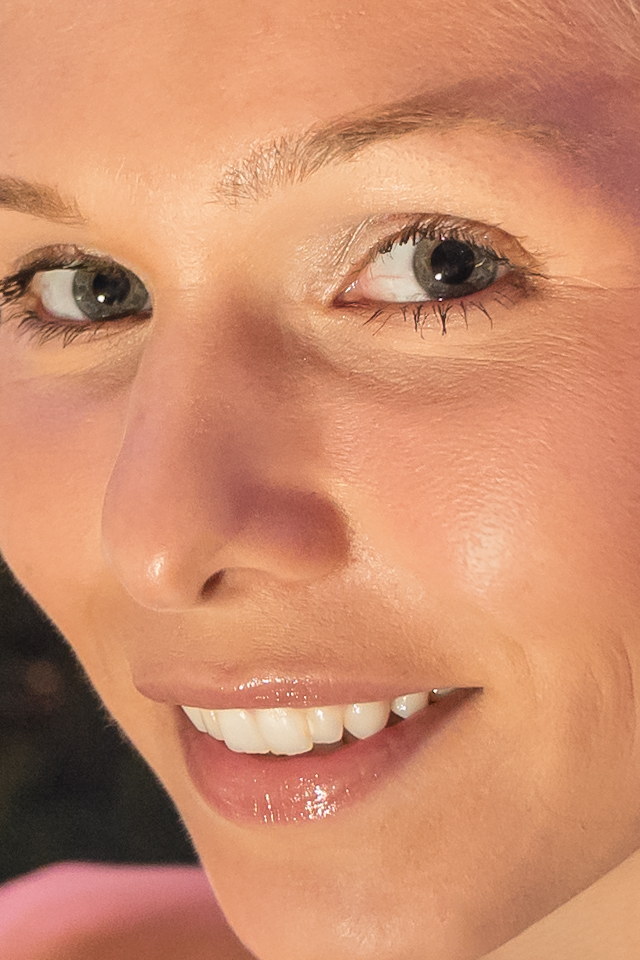
(crop with actual pixels from the title image shot at ISO 3200; model: Ilka Groenewold)
This is another example where we played with the DOF options of that lens:
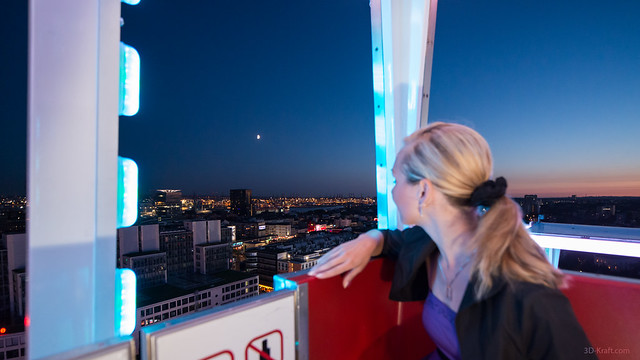
(focus on background; model: Ilka Groenewold)
When portraying people with such a lens, you will have to get very close to them and you have to be careful to not deform their faces too much. With regards to that effect, the title image was descewed a significant amount. Another example for impressive perspectives you can catch with such a lens is this shot at F3.5:
Another close up example:
So in this aspect the point goes to the Zeiss again.
Verdict
If you went together through all these examples (and further that will follow at the end of this article) with me, the conclusion is quite difficult. All three lenses have some strengths and weaknesses. My verdict:
Zeiss Distagon 15mm:
+ haptic & operation
+ extremely high center contrast and sharpness especially at F2.8
+ low distortion
+ almost no CAs
+ filters attachable
- lower edge performance than the Nikon
- significant vignetting at F2.8
- pricey
Nikon 14-24mm:
+ Autofocus (although focusing via live view is highly recommended to get best results)
+ good overall performance already at F2.8
+ very good boarder and edge performance
+ low vignetting
- some CAs
- weight and size (but ok for a F2.8 zoom)
Samyang 14mm:
+ Compact
+ good sharpness and contrast at and above F4.0
+ almost not CAs
+ low priced
- softness at open aperture
- amount and chararacteristics of distortion
- significant vignetting at F2.8
As vignetting, distortion and CAs can be quite easily corrected in post processing, these weaknesses should not be overestimated. Overall, the Zeiss is the winner for me but regarding the price / value relation the Samyang is the biggest surprise.
Further examples
If you are looking for even more examples to evaluate these lenses, you may find some here (click on the images to see other resolutions, some images are also available for all three lenses):

The same image taken with the Nikon zoom at 15mm and with the Samyang 14mm.
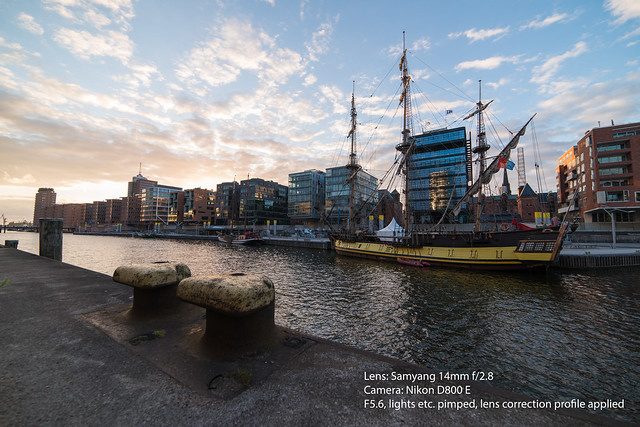
The same image taken with the Zeiss 15mm and with the Nikon zoom at 15mm.
Zeiss Distagon T* 15mm f/2.8 adapted to the NEX-7
Shooting an ultra wide angle for full frame cameras on a Sony NEX-7 may look a bit strange but as long as other alternatives producing no colorshift are missing, this may be an option.
These are examples taken with that combination (click on the images to see other avialable sizes):
The same image taken with the 15mm Zeiss and with the Nikon zoom at 15mm adapted to the NEX-7.
No guarantee / liability for misrepresentation. All images copyrighted by 3D-Kraft.com.








